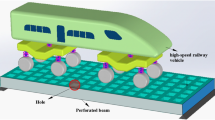Abstract
The high-speed railways require more viaduct than a conventional railway. When the viaduct is subjected to high-amplitude vibrations for a long time, the fatigue-induced crack formation can occur . The presence of a crack changes the stiffness of the structure. Depending on the location of the crack, the reduction effect in stiffness varies. In this study, the presence of a single crack in a multi-storey frame structure, which is considered as a viaduct model, has been investigated. Effects of crack location on the dynamic response are investigated via 3D velocity-crack location-dynamic magnification factor (or maximum displacement) graphs. The train is modelled as a four-axle two-bogie multi-body system with 10 DOF and moving at a constant speed. The finite element method, based on Euler–Bernoulli beam theory, is used to simulate the vibrations of the coupled vehicle-structure system. Wilson-theta time integration scheme is used to solve the equation of motion. It has been determined that when the crack is located at the midpoint of the top beam, the highest effect on the dynamic response is observed.












Similar content being viewed by others
References
Su D, Fujino Y, Nagayama T, Hernandez JY, Seki M (2010) Vibration of reinforced concrete viaducts under high-speed train passage: measurement and prediction including train-viaduct interaction. Struct Infrast Eng 6(5):621–633. https://doi.org/10.1080/15732470903068888
Guo WW, Xia H, De Roeck G, Liu K (2012) Integral model for train-track-bridge interaction on the Sesia viaduct: dynamic simulation and critical assessment. Comput Struct 112–113:205–216. https://doi.org/10.1016/j.compstruc.2012.09.001
Romero A, Solís M, Domínguez J, Galvín P (2013) Soil-structure interaction in resonant railway bridges. Soil Dyn Earthq Eng 47:108–116. https://doi.org/10.1016/j.soildyn.2012.07.014
Xia CY, Lei JQ, Zhang N, Xia H, De Roeck G (2012) Dynamic analysis of a coupled high-speed train and bridge system subjected to collision load. J Sound Vib 331(10):2334–2347. https://doi.org/10.1016/j.compstruc.2005.02.014
Majka M, Hartnett M (2008) Effects of speed, load and damping on the dynamic response of railway bridges and vehicles. Comput Struct 86(6):556–572. https://doi.org/10.1016/j.compstruc.2007.05.002
Dimitrakopoulos EG, Zeng Q (2015) A three-dimensional dynamic analysis scheme for the interaction between trains and curved railway bridges. Comput Struct 149:43–60. https://doi.org/10.1016/j.compstruc.2014.12.002
Lee YS, Kim SH (2010) Structural analysis of 3D high-speed train-bridge interactions for simple train load models. Veh Syst Dyn 48(2):263–281. https://doi.org/10.1080/00423110902751912
Lou P, Dai GL, Zeng QY (2005) Modal coordinate formulation for a simply supported bridge subjected to a moving train modelled as two-stage suspension vehicles. Proc Inst Mech Eng C J Mech Eng Sci 219(10):1027–1040. https://doi.org/10.1243/095440605X31940
Duan YF, Wang SM, Wang RZ, Wang CY, Shih JY, Yun CB (2018) Vector form intrinsic finite-element analysis for train and bridge dynamic interaction. J Bridge Eng 23(1):1–15. https://doi.org/10.1061/(ASCE)BE.1943-5592.0001171
Hubbell D, Gauvreau P (2018) Frequency domain analysis of train guideway interaction. Dynamics 144(8):1–11. https://doi.org/10.1055/s-0035-1570321
Wu YS, Yang YB (2003) Steady-state response and riding comfort of trains moving over a series of simply supported bridges. Eng Struct 25(2):251–265. https://doi.org/10.1016/S0141-0296(02)00147-5
Youcef K, Sabiha T, El Mostafa D, Ali D, Bachir M (2013) Dynamic analysis of train-bridge system and riding comfort of trains with rail irregularities. J Mech Sci Technol 27(4):951–962. https://doi.org/10.1007/s12206-013-0206-8
Biondi B, Muscolino G, Sofi A (2005) A substructure approach for the dynamic analysis of train-track-bridge system. Comput Struct 83(28-30 SPEC. ISS.): 2271–2281
Xiang T, Zhao R, Xu T (2007) Reliability evaluation of vehiclebridge dynamic interaction. J Struct Eng 133(8):1092–1099. https://doi.org/10.1061/(ASCE)0733-9445(2007)133:8(1092)
Yang YB, Chang CH, Yau JD (1999) An element for analysing vehicle-bridge systems considering vehicle’s pitching effect. Int J Numer Methods Eng 46:1031–1047
Lin CC, Wang JF, Chen BL (2005) Train-induced vibration control of high-speed railway bridges equipped with multiple tuned mass dampers. J Bridge Eng 10(4):398–414. https://doi.org/10.1061/(ASCE)1084-0702(2005)10:4(398)
Demirtas S, Ozturk H, Sabuncu M (2019) Dynamic response of multi-bay frames subjected to successive moving forces. Int J Struct Stab Dyn 19(4):1950042. https://doi.org/10.1142/S0219455419500421
Wu JJ (2008) Transverse and longitudinal vibrations of a frame structure due to a moving trolley and the hoisted object using moving finite element. Int J Mech Sci 50(4):613–625. https://doi.org/10.1016/j.ijmecsci.2008.02.001
Bathe KJ (1996) Finite element procedures, 2nd edn. Prentice Hall, Upper Saddle River
Qian GL, Gu SN, Jiang JS (1990) The dynamic behaviour and crack detection of a beam with a crack. J Sound Vib 138(2):233–243. https://doi.org/10.1016/0022-460X(90)90540-G
Shifrin E, Ruotolo R (1999) Natural frequencies of a beam with an arbitrary number of cracks. J Sound Vib 222:409–423. https://doi.org/10.1006/jsvi.1998.2083
Author information
Authors and Affiliations
Corresponding author
Additional information
Technical Editor: Marcelo Areias Trindade.
Publisher's Note
Springer Nature remains neutral with regard to jurisdictional claims in published maps and institutional affiliations.
Appdendix
Appdendix
In Eq. (13), the following abbreviations have been introduced:
where \(i=1,2,3,4\).
Notation \(\varvec{A}<q_j^{ei}>\) represents the \(j{\rm th}\) column of the element ei in the matrix \(\varvec{A}\). If \(\varvec{A}\) and a in matrices \(\varvec{\bar{A}}_{vf}\) and \(\varvec{A}_{v}\) in Eqs. (20) and (22) are replaced by \(\varvec{C}\) and c (or \(\varvec{K}\) and k), matrices \(\varvec{\bar{C}}_{vf}\) and \(\varvec{C}_v\) (or matrices \(\varvec{\bar{K}}_{vf}\) and \(\varvec{K}_v\)) can be determined.
Rights and permissions
About this article
Cite this article
Demirtaş, S., Ozturk, H. Effects of the crack location on the dynamic response of multi-storey frame subjected to the passage of a high-speed train. J Braz. Soc. Mech. Sci. Eng. 43, 80 (2021). https://doi.org/10.1007/s40430-020-02794-5
Received:
Accepted:
Published:
DOI: https://doi.org/10.1007/s40430-020-02794-5




